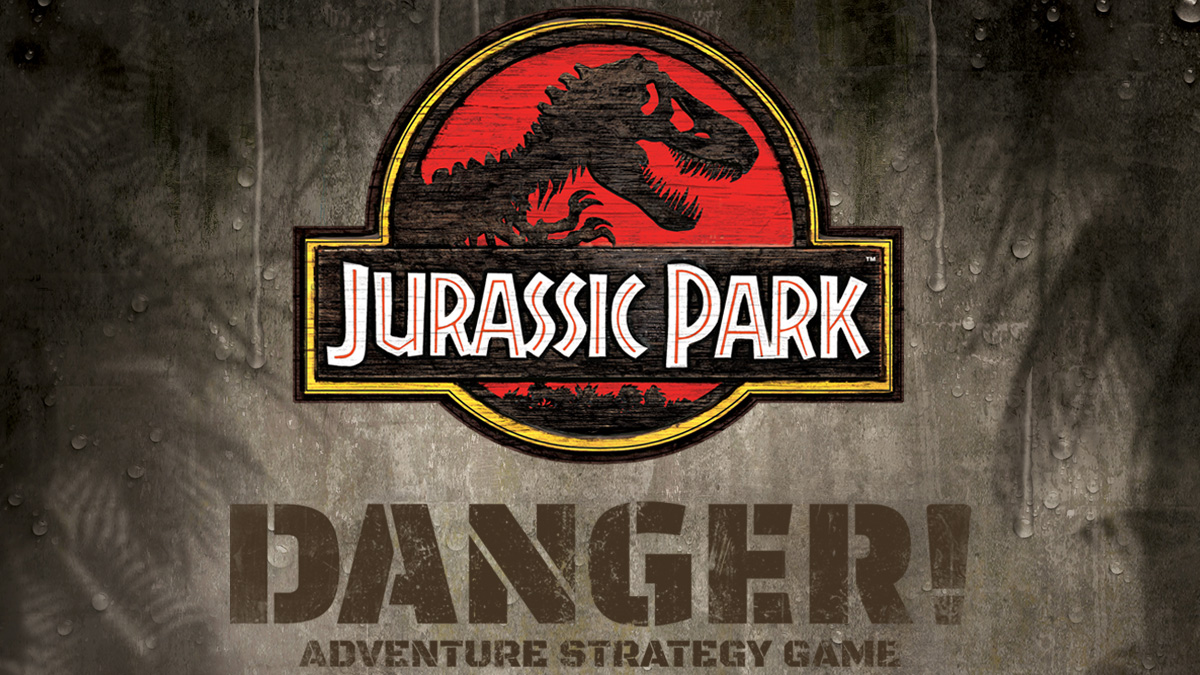
What is Jurassic Park: Danger?
Jurassic Park: Danger is a semi-cooperative board game by Ravensburger available exclusively from Target and which is based on the original Jurassic Park movie. In order for the Human Players to win they must accomplish their goals, activate the locations, and escape from the island, but the Dinosaur Player is out to stop them and win by eliminating Characters from the game.
Components

- 19 Island Tiles (12 Perimeter Tiles, 6 Centre Tiles, 1 Start Tile)
- 6 Island Perimeter Pieces
- 10 Character Player Mats
- 10 Character Meeples
- 100 Character Cards (10 Character Decks of 10 Cards Each)
- 10 Dinosaur Cards
- 1 Dinosaur Player Mat
- 3 Dinosaur Meeples
- 13 Fence Tokens
- 10 Character Goal Tokens
- 4 Lock Tokens
- 3 Location Tokens (Maintenance Shed, Control Centre, Visitors Centre)
- 1 Dinosaur Action Token
- 1 Helicopter Token
- 1 Die
- Instructions
How Do You Play Jurassic Park: Danger?
Setup
A game of Jurassic Park: Danger begins by building the board. The five perimeter pieces fit together like a jigsaw in order to form the iconic shape of Isla Nublar. Once this is built, the 12 perimeter tiles are placed at random into the outer circle, followed by the six center tiles, also at random, forming the inner circle. The Start tile is placed in the very center of the board.
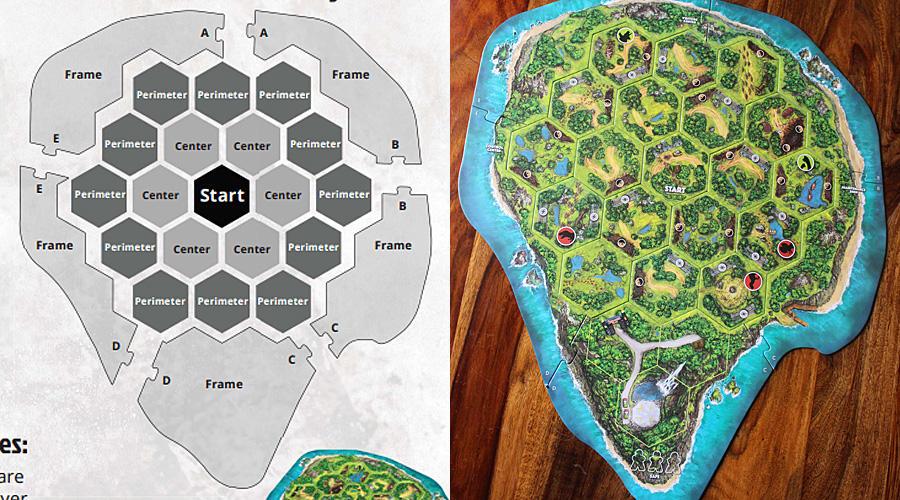
The Maintenance Shed, Control Center, and Visitors Center tokens are placed gray side up on the perimeter tiles adjacent to the corresponding labels on the frame. The lock tokens, fence tokens, goal tokens, helicopter token, and die are placed beside the game board for later use.
Human Players Setup
Each Human Player chooses a Character to play, either at random or by preference. In a two-player game, the Human Player chooses two Characters to play. The Human Players take their Character’s player mat and place it in front of them, they then take that Character’s card deck and shuffle it to form their hand. Finally, they place the matching color meeple on the Start tile, read aloud their Character’s goal, and place their Goal Token on either the appropriate tile or on their player mat depending on what the goal is.
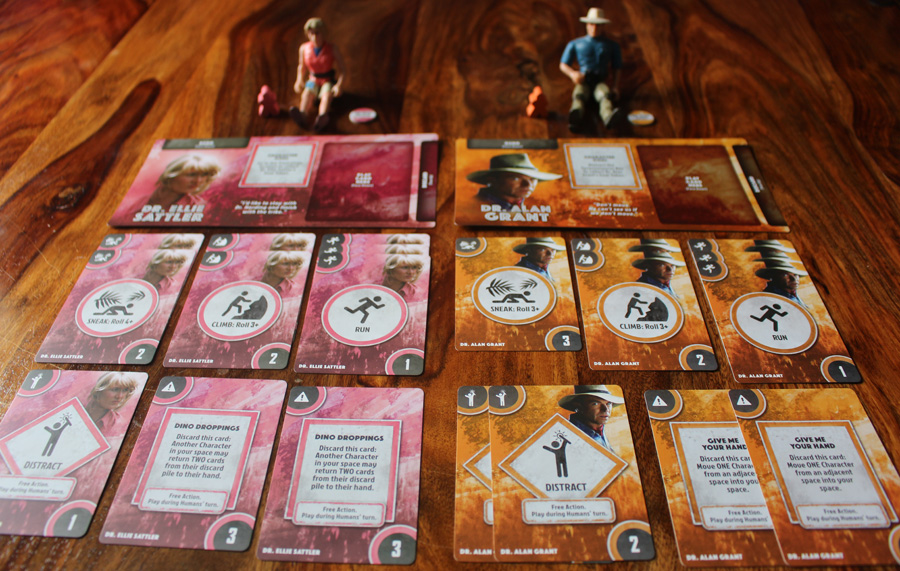
Dinosaur Player Setup
The Dinosaur Player places the Dinosaur player mat in front of them along with the dinosaur token which should be placed on the Rest spot. Next, they take the Dinosaur card deck and shuffle it, then take three cards to form their starting hand. Finally, they place the three dinosaur meeples on the corresponding dinosaur spaces on the board.
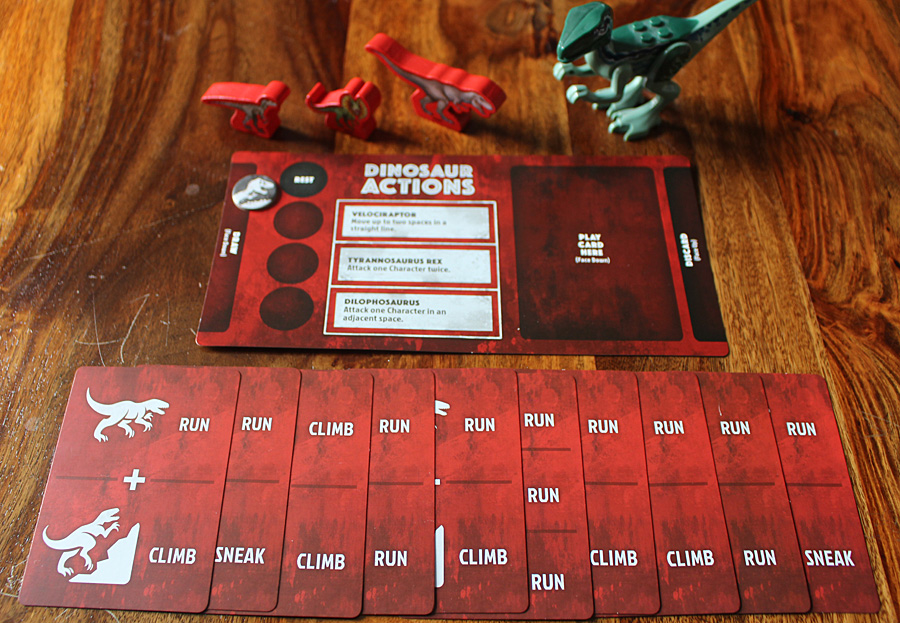
The game is now ready to play.
Gameplay
The aim of Jurassic Park: Danger for the humans is to replicate the events of the movie. They must visit various locations across the board in order to activate them and escape from the island. Each Character also has a unique goal they must achieve before they can escape. Meanwhile, the Dinosaurs are attempting to attack the humans and eliminate them from the game.
Goals
Every human character has a Goal Token which is tied to their personal storyline in the original film. Some characters begin with their Goal Token and must keep hold of it, while others must earn their token during gameplay. Some examples of Character goals include:
- Dr. Alan Grant – Distract the T-Rex
- Dr. Ellie Sattler – Go to the Triceratops Location
- Dr. Ian Malcolm – Successfully guess odd or even when rolling
- Donald Gennaro – Begins with his token but loses it if he is ever attacked

Characters cannot escape the island if they do not have their Goal Token, and so these goals may help you decide which characters to sacrifice (you WILL need to sacrifice human characters in order to allow others to escape). For example, if a character such as Donald Gennaro has lost their goal token they cannot earn it back and therefore cannot escape. In this instance, it makes sense to sacrifice the Character elsewhere on the board and allow someone else to escape.
Activating Locations
The Characters must visit the Maintenance Shed, Control Centre, and Visitors Centre and activate all three locations by rolling a five or higher while on that space. The buildings can be activated in any order, and activating them triggers new conditions in the game.
- Control Center – Once this is activated, all three buildings and the Helipad are locked. This means that the Dinosaurs can no longer access these spaces and the Characters are safe whenever they are on those spaces. If a Dinosaur is on one of these spaces when the Control Centre is activated, they are pushed out to an adjacent space of the Human Players’ choice.
- Visitors Center – Once activated, the Human Player who activated it can choose two cards from their discard pile and return them to their hand.
- Maintenance Shed – Activating this building allows the Human Players to decide whether or not to switch on the electric fences. If the Human Players switch them on, they place the colored fence tokens onto each fence space on the board. Neither the Dinosaurs nor the Characters can now pass through these borders. The Human Players must think very carefully about whether or not to activate the fences because while they will hinder the Dinosaurs, they are likely to hinder their Characters just as much.

Once all three locations have been activated, the Helicopter Pad token is added to the board. Characters may travel to the helipad space and wait there before the token is added, but they cannot escape and win the game for the Humans until the token is placed.
If a Character makes it to the Helipad before the end of the game, the Human Player selects a new Character to start playing just as they would if their Character had been eliminated. Human Players may also choose to eliminate a character by choice in order to bring a new Character into the game, however, this elimination will also count towards the Dinosaur Player’s victory.
Dinosaur Actions
In addition to their move cards, each of the three Dinosaurs has a special Dinosaur Action they may perform. Only one Dinosaur Action may be performed per round, and the same one cannot be used in two consecutive rounds but they can be used whether or not that dinosaur was moved on this turn. The optional actions are:
- Velociraptor – Move up to two spaces in a straight line
- T-Rex – Attack a Character twice when you are in the same space as them
- Dilophosaurus – Attack one Character in an adjacent space including over cliffs and through deactivated electric fences. The Dilophosaurus cannot attack Characters behind live electric fences or in spaces which are locked after activating the Control Center.
Dinosaur Attacks
A Dinosaur attacks by moving into a space containing a non-sneaking Character (if there are more than one Characters in the same space, the Human Players decide who is attacked unless one is Dennis Nedry, who must always be attacked first). Dinosaurs can also attack if a Character reveals from a Sneak in a space occupied by a Dinosaur, or by using a Special Action in the case of the Dilophosaurus.
When the Dinosaur attacks, the Dinosaur Player takes one card from the Human Player’s hand and adds it to that player’s Burn Pile. The Human Player may look at the card to see which one it is, but the Dinosaur Player may not see.

Eliminating Characters
The Dinosaurs must eliminate three Characters in order to win and there are three ways they can do this.
- If a Dinosaur attacks a Character and the Human Player has no cards in their hand, that Character is eliminated.
- If a Human Player has no cards in their hand at the end of their turn, that Character is eliminated.
- If a Human Player cannot select a card when required, that Character is eliminated.
When a Character is eliminated, the Dinosaur Player takes that Character’s meeple and places it on their Player Mat. The Character’s mat, cards, and goal token are then returned to the box and the Human Player draws a new Character at random to start playing with.
Round and Turn Order
A game of Jurassic Park: Danger is played over a number of rounds, each of which is split into the following four turns.
1. Dinosaur Player Selects a Card

The Dinosaur Player looks at their hand of three cards and chooses which card to play this round. At this stage, the card is chosen but the action is not performed. Each Dinosaur card has a combination of either two or three different move options on it. These are:
- Run – Move a Dinosaur into an adjacent space as long as it does not cross a cliff or electric fence
- Climb – Move a Dinosaur into an adjacent space as long as it does cross a cliff or electric fence
- Sneak – Lay a Dinosaur on its side. In the next Round, it can re-appear either in its current space or in an adjacent space, before taking its next move.
If possible, the Dinosaur Player needs to use all the moves on their chosen card, using a different Dinosaur for each one. Once the Dinosaur Player has chosen their card, they place it face down on their player mat.
2. Human Players Select a Card
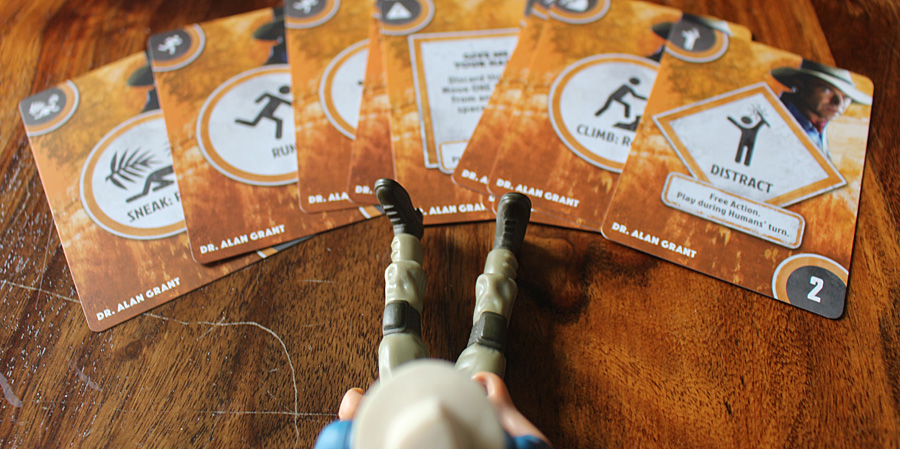
Each of the Human Players selects one card from their hand and places it face-down on their player mat. There are three types of movement cards that the human players can select at this stage:
- Run – As with the Dinosaur version of this card, this allows the Character to move into an adjacent space as long as they do not cross a cliff or electric fence. Characters cannot move into a space containing a Dinosaur unless the Dinosaur is sneaking.
- Climb – Move a Character into an adjacent space as long as they do cross a cliff or electric fence. Unlike Dinosaurs, Characters must roll the die in order to successfully climb and sneak, but this is done later.
- Sneak – Lay the Character’s meeple on its side. In the next Round, it can re-appear either in its current space or in any adjacent space, before taking its next move.
Once every Character has chosen a card and placed it face down on their player mat, the next turn in the round begins.
3. Dinosaurs Move
The Dinosaur Player reveals their card. They may then perform the moves listed on the card and take an optional Dinosaur Action in any order. If the Dinosaur Player chooses to use a special Dinosaur Action, they place the token beside that action to show that is has been used and cannot be used in the next round.
Once the Dinosaur Player has used all the moves on their card, a special Dinosaur Action if they wish to, and any attacks they can perform, they draw another card from their deck into their hand, and their turn ends.
4. Characters Move
All the Human Players reveal their cards simultaneously. They then perform their moves and play any optional free action cards they wish to in any order. If a Character cannot complete their move after their card has been revealed, or if a Human Player no longer wants to move their Character, the card can be placed into the Player’s discard pile without being completed.
Unlike the Dinosaurs, Characters must roll to complete actions including climbing, sneaking, and activating locations. The roll requirements are different depending on which character you are playing, for example, little Timmy only has to roll a two or higher in order to sneak, but finds it harder to climb and must roll four or more in order to do that, whereas his sister Lex needs to roll a three or higher for both moves. All Characters must roll a five or higher to activate the locations in the park.
If a Character fails to roll the required number in order to successfully climb or sneak, they have two choices. They can either take the failed card back into their hand and try again on the next round, or they can burn cards in order to reach the required number. Each card has a number in the lower right corner, this number can be added to your roll by burning that card. The burning method can also be used to activate locations.
For example, John Hammond needs to climb. In order to do so, he needs to roll a four or higher, but here he has only rolled a one. The player chooses to burn one of his sneak cards with a value of three to make up the difference and allow John Hammond to successfully climb to an adjacent space.
At the end of the Humans Player’s turn, they may choose to burn all the remaining cards in their hand in order to reclaim all the cards in their discard pile. All burned cards are added to a separate pile and are out of the game for good. This means that the Human Player’s decks constantly dwindle.
Winning
The Human Players win a game of Jurassic Park: Danger by successfully activating the Maintenance Shed, Control Centre, and Visitors Centre. Then either two or three characters (two in a 2-3 player game, three in a 4-5 player game) must make it to the Helicopter Pad with their Goal Tokens.
The dinosaurs win by eliminating three characters.
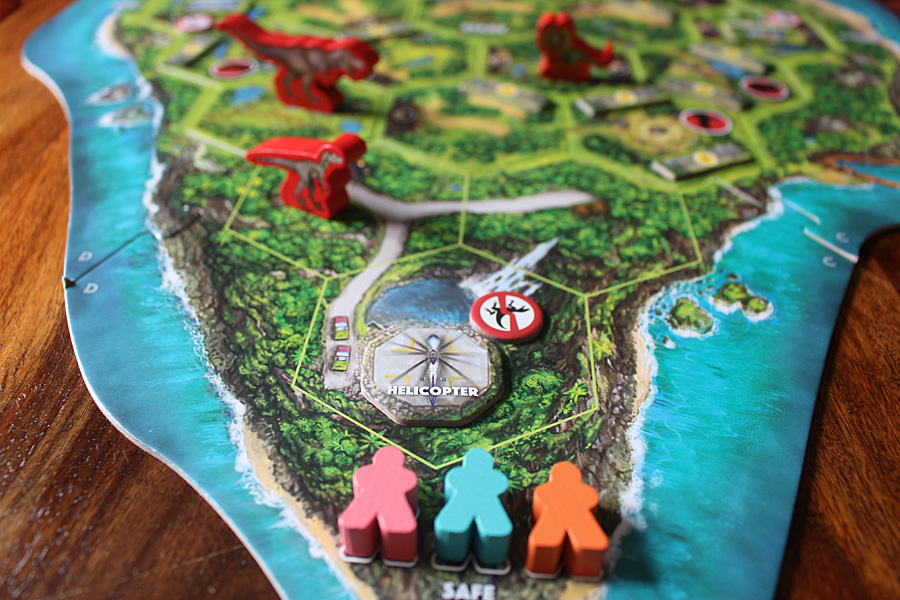
Why Should You Play Jurassic Park: Danger?
Jurassic Park: Danger is a fantastically themed game that takes you right into the movie. The game does a great job of capturing dozens of moments from the film while not becoming a simple and repetitive blow-by-blow recreation of the storyline. All the characters you would expect to see are here, and even some of the lesser remembered ones as well, plus all your favorite dinosaurs are there to cause the havoc you expect from a Jurassic Park game.
In terms of the gameplay itself, Jurassic Park: Danger combines elements of Colt Express with Forbidden Island. Building the board from 18 changeable tiles, each of which can be rotated in six different ways, means that every game is different because there are literally hundreds of different combinations. Add to that the ten playable Characters, each with a different goal to achieve which will affect their decisions based on how soon they came into play, and you’ll never have two games the same.
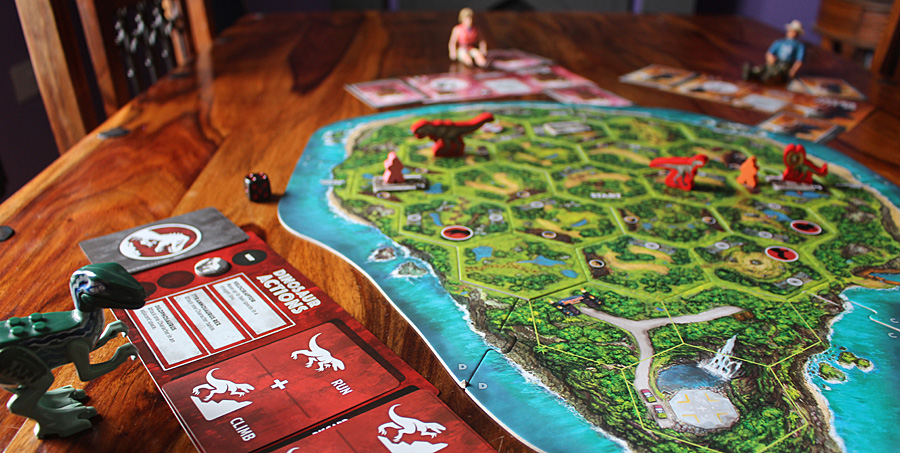
For the most part, the game is beautifully made. The board is very high-quality, as are the cards, tokens, and meeples, although I’d have loved to see more personality in the Character meeples like we see with the Dinosaurs. The player mats are rather flimsy, but given that these mats stay sat on the table all through the game, this is a minor criticism at best. I had been concerned about the quality of this game given that it is being produced for a more mass-market distribution that most European-style board games I play, but there were no cheap plastic pieces to be found here.
That being said, I cannot be wholly positive about Jurassic Park: Danger. The mechanic feels hopelessly weighted in favor of the Dinosaurs for many reasons. The Characters are limited in their movements thanks to the small number of run and climb cards in their hand. They are also often forced to take less convenient, indirect routes between locations. For example, if a Character is trying to move onto a tile where there are no cliffs or fences along the border, but they only have climb or sneak cards, they are forced to either take an alternate route over a fence or cliff, or to attempt sneaking. They may also repeatedly fail to climb or sneak if they do not roll high enough, forcing them to remain stationary or to burn cards in order to move. The Dinosaurs are not as limited in terms of their movement. They don’t have to roll in order to climb and sneak, and their special abilities allow them to move much faster than the Characters or attack from a distance as well.
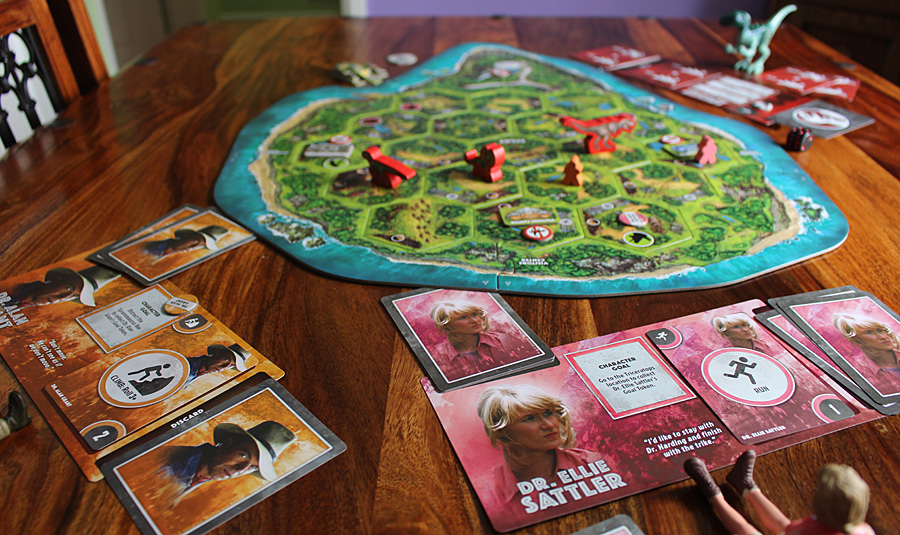
We played Jurassic Park: Danger many times, with different numbers of players, and the Humans only ever won once by playing with the intention of sacrificing many Characters from the outset and having other Characters run to safety without making any effort to help out in the game overall. In every other game we played, not a single Character ever even made it to the Helipad. While this is an entirely valid way of playing, it feels as if the Humans need to give up any immersion in the story of the game in order to have even a slither of hope at winning. We weren’t the only ones to feel that way, The Board Game Family also reviewed the game recently and felt the same way about how unbalanced the game feels.
I love Jurassic Park, it’s my favorite movie of all time, and because of that, I desperately wanted to love Jurassic Park: Danger too. Annoyingly, I don’t. I like it a lot, but I can’t bring myself to love a game that always feels unfairly unbalanced to one player’s advantage. I also felt that the game was somewhat boring for the Dinosaur Player, who would move their Dinosaurs, then sit there for a long time while the Human Players discussed, rolled, and moved all their Characters.
Thematically, Jurassic Park: Danger is near-perfect, and fans of the movie will probably enjoy playing it anyway, but I just can’t help but see the problems whenever I play and so this one probably won’t be coming off the shelf all that often.
GeekMom received this item for review purposes.



